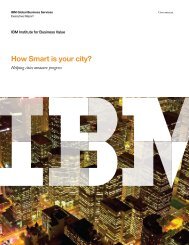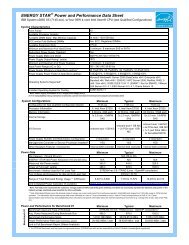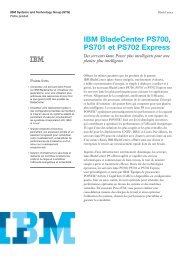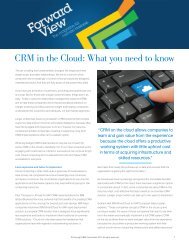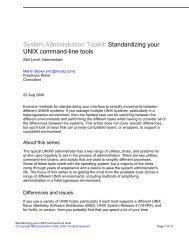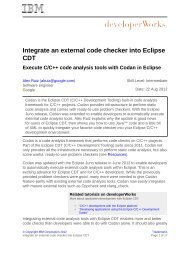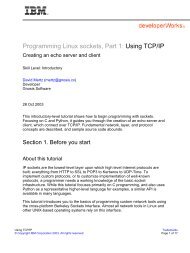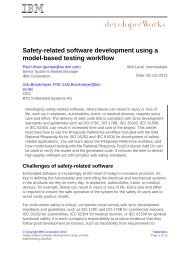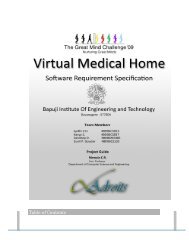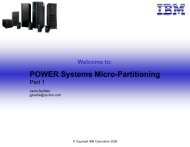Power Storage Solid State Drives - IBM
Power Storage Solid State Drives - IBM
Power Storage Solid State Drives - IBM
Create successful ePaper yourself
Turn your PDF publications into a flip-book with our unique Google optimized e-Paper software.
<strong>IBM</strong> Systems Group<br />
<strong>Power</strong> <strong>Storage</strong><br />
<strong>Solid</strong> <strong>State</strong> <strong>Drives</strong><br />
Sept 22, 2009<br />
Dan Braden dbraden@us.ibm.com<br />
AIX Advanced Technical Support<br />
http://w3.ibm.com/support/americas/pseries<br />
© 2009 <strong>IBM</strong> Corporation
Agenda<br />
SSD technology overview<br />
SSD performance and sizing<br />
Positioning<br />
SSD options for AIX<br />
SSD in DS8000<br />
Configuring SSD and configuration options<br />
Choosing data to place on SSDs<br />
© 2009 <strong>IBM</strong> Corporation
SSD technology<br />
Uses SLC (single level cell) flash memory technology<br />
Prices coming down fast so expect to see more in the future<br />
Very fast IOs, but limited life<br />
Approximately 1,000,000 writes to a cell maximum<br />
Over provisioned – 69 GB available, 128 GB used<br />
Wear leveling – writes are spread around<br />
Bad block relocation<br />
ECC<br />
Low power requirement ~ 90% less<br />
Space savings (one SSD replacing many HDDs)<br />
High cost<br />
About 22X more per GB vs. HDD<br />
One SSD costs about the same as 10.25 HDDs<br />
Costs include adapter, enclosure, maintenance and power<br />
8000<br />
7000<br />
6000<br />
5000<br />
4000<br />
3000<br />
2000<br />
1000<br />
0<br />
SSD HDD<br />
<strong>Power</strong> Consumption<br />
Watts Required for 135K IOPS<br />
performance<br />
© 2009 <strong>IBM</strong> Corporation
SSD performance and sizing<br />
100% random 4<br />
KB reads<br />
100% random 4<br />
KB writes<br />
Mixed<br />
reads+writes 4 KB<br />
Sequential reads<br />
large block<br />
Sequential writes<br />
large block<br />
14,000<br />
PAWS<br />
Single SSD<br />
29,000 IOPS<br />
21,000 IOPS<br />
240 MB/s<br />
125 MB/s<br />
Ndisk<br />
Single SSD<br />
26.234 IOPS<br />
(102 MB/s)<br />
16,669 IOPS<br />
16,110 IOPS<br />
20% reads<br />
240 MB/s<br />
124.5 MB/s<br />
Internal SAS adapter for ndisk, adapter with cache for PAWS<br />
Adapters can easily become a bottleneck<br />
Adapter<br />
maximums<br />
60,837 IOPS<br />
(237 MB/s)<br />
58,068 IOPS<br />
59,359 IOPS<br />
70% read<br />
666 MB/s<br />
302 MB/s<br />
Use of write cache on adapter usually reduces adapter bandwidth<br />
Consider dedicating an adapter to SSDs<br />
Use of RAID 1/5/6/10 or LVM mirroring affects performance<br />
A HDD can do about 200 IOPS max<br />
© 2009 <strong>IBM</strong> Corporation
High IOPS applications<br />
SSD positioning<br />
Existing customers using many physical disks, often with lots of<br />
unused storage capacity<br />
One SSD can potentially replace 100+ HDDs<br />
High %iowait or inadequate application performance<br />
Potential to improve application thruput/response time<br />
Mostly reads<br />
Writes get good IO service times with write cache<br />
Random IO<br />
HDDs provide relatively good sequential performance<br />
High access density (IOPS/GB) data<br />
Data placement is critical<br />
Boot support<br />
© 2009 <strong>IBM</strong> Corporation
There are tradeoffs<br />
SAS adapter write cache<br />
IOPS bandwidth usually greater with write cache turned off<br />
Adapter processor has more work to do handling cache and/or RAID<br />
Write IO latency slightly better with write cache turned on<br />
Adapters in HA configurations require writing data to cache on both adapters<br />
RAID 5 write penalty increases write IO latency with adapter cache turned off<br />
Sequential write threads allow adapter to perform full stripe writes, but<br />
sequential IO should usually be on HDDs<br />
Rt (ms)<br />
9<br />
8<br />
7<br />
6<br />
5<br />
4<br />
3<br />
2<br />
1<br />
0<br />
4KB/op Read Response Time<br />
0.1<br />
0.33<br />
3.9<br />
IOA Cache Hit SSD 15k RPM HDD<br />
Short Seek<br />
8<br />
15k RPM HDD<br />
Long Seek<br />
© 2009 <strong>IBM</strong> Corporation
OLTP1 (60 % read, 4KB I/Os)<br />
procs<br />
procs<br />
procs<br />
1<br />
4<br />
8<br />
24<br />
48<br />
96<br />
OLTP2 (90 % read, 8KB I/Os)<br />
1<br />
4<br />
8<br />
24<br />
48<br />
96<br />
1<br />
4<br />
8<br />
24<br />
48<br />
96<br />
Some SSD performance data<br />
IOPS<br />
IOPS<br />
IOPS<br />
1 Drive RAID0<br />
SSD cache off<br />
2,641<br />
6,260<br />
8,873<br />
12,399<br />
12,488<br />
12,635<br />
2,496<br />
6,381<br />
8,472<br />
10,661<br />
10,654<br />
10,364<br />
4,015<br />
10,598<br />
15,376<br />
21,068<br />
21,471<br />
21,013<br />
RT<br />
1 Drive RAID0<br />
SSD cache off<br />
RT<br />
1 Drive RAID0<br />
SSD cache off<br />
RT<br />
0.37<br />
0.64<br />
0.90<br />
1.93<br />
3.84<br />
7.59<br />
0.40<br />
0.62<br />
0.94<br />
2.25<br />
4.50<br />
9.26<br />
0.25<br />
0.37<br />
0.52<br />
1.14<br />
2.23<br />
4.56<br />
IOPS<br />
IOPS<br />
IOPS<br />
SSD cache on<br />
3,320<br />
10,157<br />
16,095<br />
21,810<br />
21,875<br />
21,740<br />
2,995<br />
9,018<br />
14,851<br />
27,960<br />
33,649<br />
35,071<br />
OLTP3 (70% read, 4KB I/Os, 50% read cache hit, 66% write cache hit)<br />
SSD cache on<br />
4,841<br />
15,719<br />
24,372<br />
28,920<br />
28,586<br />
28,517<br />
RT<br />
SSD cache on<br />
RT<br />
RT<br />
6 Drive RAID0<br />
0.30<br />
0.39<br />
0.49<br />
1.10<br />
2.19<br />
4.38<br />
0.33<br />
0.44<br />
0.53<br />
0.85<br />
1.43<br />
2.73<br />
6 Drive RAID0<br />
0.20<br />
0.25<br />
0.32<br />
0.83<br />
1.68<br />
3.36<br />
IOPS<br />
6 Drive RAID0<br />
IOPS<br />
IOPS<br />
SSD cache off<br />
3,474<br />
10,567<br />
17,211<br />
34,012<br />
47,820<br />
54,314<br />
2,793<br />
9,113<br />
15,222<br />
29,923<br />
38,897<br />
43,903<br />
SSD cache off<br />
4,943<br />
16,467<br />
27,603<br />
52,638<br />
59,359<br />
59,005<br />
RT<br />
SSD cache off<br />
RT<br />
RT<br />
0.28<br />
0.37<br />
0.46<br />
0.70<br />
1.00<br />
1.76<br />
0.35<br />
0.43<br />
0.52<br />
0.80<br />
1.23<br />
2.18<br />
0.20<br />
0.24<br />
0.29<br />
0.45<br />
0.80<br />
1.62<br />
IOPS<br />
IOPS<br />
IOPS<br />
SSD cache on<br />
2,957<br />
8,384<br />
12,262<br />
14,064<br />
13,913<br />
13,893<br />
SSD cache on<br />
2,427<br />
6,889<br />
10,737<br />
19,763<br />
24,324<br />
25,245<br />
SSD cache on<br />
4,379<br />
12,918<br />
18,861<br />
20,712<br />
20,557<br />
20,553<br />
RT<br />
RT<br />
RT<br />
6 Drive RAID5<br />
0.33<br />
0.47<br />
0.65<br />
1.70<br />
3.45<br />
6.91<br />
6 Drive RAID5<br />
0.41<br />
0.58<br />
0.74<br />
1.21<br />
1.97<br />
3.80<br />
6 Drive RAID5<br />
0.23<br />
0.31<br />
0.42<br />
1.15<br />
2.33<br />
4.67<br />
IOPS<br />
IOPS<br />
IOPS<br />
SSD cache off<br />
1,619<br />
5,009<br />
8,105<br />
15,704<br />
21,551<br />
23,264<br />
SSD cache off<br />
2,181<br />
6,689<br />
10,869<br />
20,780<br />
27,626<br />
30,941<br />
SSD cache off<br />
2,851<br />
9,126<br />
14,877<br />
26,062<br />
27,234<br />
26,743<br />
RT<br />
RT<br />
RT<br />
0.61<br />
0.79<br />
0.98<br />
1.52<br />
2.22<br />
4.12<br />
0.45<br />
0.59<br />
0.73<br />
1.15<br />
1.73<br />
3.10<br />
0.35<br />
0.43<br />
0.53<br />
0.92<br />
1.76<br />
3.59<br />
© 2009 <strong>IBM</strong> Corporation
Some SSD performance data<br />
Read Miss 4KB<br />
procs<br />
procs<br />
1<br />
4<br />
8<br />
24<br />
48<br />
96<br />
Write Miss 4KB<br />
1<br />
4<br />
8<br />
24<br />
48<br />
96<br />
1 Drive RAID0<br />
SSD cache off<br />
IOPS<br />
3,035<br />
11,862<br />
22,022<br />
27,467<br />
27,455<br />
27,469<br />
IOPS<br />
7,849<br />
19,847<br />
20,187<br />
20,599<br />
20,458<br />
20,371<br />
RT<br />
SSD cache off<br />
RT<br />
0.33<br />
0.33<br />
0.36<br />
0.87<br />
1.74<br />
3.49<br />
1 Drive RAID0<br />
0.12<br />
0.20<br />
0.39<br />
1.16<br />
2.34<br />
4.71<br />
SSD cache on<br />
IOPS<br />
3,027<br />
11,972<br />
23,420<br />
57,643<br />
58,679<br />
58,463<br />
IOPS<br />
6,340<br />
13,466<br />
13,271<br />
13,251<br />
13,190<br />
13,268<br />
RT<br />
SSD cache on<br />
RT<br />
6 Drive RAID0<br />
0.33<br />
0.33<br />
0.34<br />
0.41<br />
0.81<br />
1.64<br />
6 Drive RAID0<br />
0.15<br />
0.29<br />
0.60<br />
1.81<br />
3.64<br />
7.23<br />
SSD cache off<br />
IOPS<br />
3,030<br />
11,987<br />
23,433<br />
59,650<br />
60,583<br />
60,320<br />
SSD cache off<br />
IOPS<br />
7,931<br />
28,055<br />
45,340<br />
58,219<br />
58,004<br />
57,818<br />
RT<br />
RT<br />
0.33<br />
0.33<br />
0.34<br />
0.41<br />
0.79<br />
1.59<br />
0.12<br />
0.14<br />
0.17<br />
0.41<br />
0.82<br />
1.66<br />
SSD cache on<br />
IOPS<br />
2,976<br />
11,744<br />
22,726<br />
41,004<br />
40,724<br />
40,608<br />
SSD cache on<br />
IOPS<br />
5,597<br />
7,024<br />
6,988<br />
6,938<br />
6,960<br />
6,987<br />
RT<br />
RT<br />
6 Drive RAID5<br />
0.33<br />
0.34<br />
0.35<br />
0.58<br />
1.18<br />
2.36<br />
6 Drive RAID5<br />
0.17<br />
0.57<br />
1.14<br />
3.46<br />
6.89<br />
13.74<br />
SSD cache off<br />
IOPS<br />
2,994<br />
11,843<br />
22,919<br />
43,393<br />
43,239<br />
42,912<br />
SSD cache off<br />
IOPS<br />
970<br />
2,907<br />
4,600<br />
8,802<br />
11,845<br />
11,865<br />
RT<br />
RT<br />
0.33<br />
0.33<br />
0.35<br />
0.55<br />
1.11<br />
2.23<br />
1.03<br />
1.37<br />
1.74<br />
2.72<br />
4.05<br />
8.09<br />
© 2009 <strong>IBM</strong> Corporation
SSD RAID sizing theory<br />
Use of RAID 1/5/6/10: application IOPS do not equal physical IOPS<br />
Use these formulas to determine potential application IOPS<br />
N = number of SSDs<br />
R = proportion of IOs that are reads<br />
W = 1-R = proportion of IOs that are writes<br />
D = IOPS for a single SSD (use 16,000 to be conservative unless all R or W)<br />
JBOD or RAID 0<br />
IOPS bandwidth = NxD<br />
RAID 1 or RAID 10<br />
IOPS bandwidth = NxD/(R+2W)<br />
RAID 5<br />
IOPS bandwidth = NxD/(R+4W)<br />
RAID 6<br />
IOPS bandwidth = NxD/(R+6W)<br />
Take into account adapter bandwidths<br />
This does not take into account adapter processor bottlenecks<br />
6 disk RAID 5 write IOPS bandwidth is only 11,865 IOPS<br />
Processor must issue 4 IOs and calculate parity for each application write<br />
© 2009 <strong>IBM</strong> Corporation
SSD RAID sizing theory<br />
Example 1: 3 SSDs in a RAID 5 configuration 90% reads<br />
IOPS bandwidth = NxD/(R+4W) = 3x16,000/(0.9+4x0.1) = 36,923 IOPS<br />
This is less than the adapter bandwidth of 59,359 IOPS<br />
Example 2: 3 SSDs in a RAID 5 configuration 10% reads<br />
IOPS bandwidth = NxD/(R+4W) = 3x16,000/(0.1+4x0.9) = 12,973 IOPS<br />
Example 3: 6 SSDs in a RAID 5 configuration 80% reads<br />
IOPS bandwidth = 6x16,000/(0.8+4x0.2) = 60,000 IOPS<br />
This is more than the adapter bandwidth of 59,359 IOPS<br />
© 2009 <strong>IBM</strong> Corporation
66,550 MB<br />
SAS Disk<br />
SSD options for AIX<br />
3.5 inch<br />
Small Form Factor (SFF)<br />
2.5 inch SAS<br />
EXP 12S SAS FC#5886<br />
Disk Drawer<br />
p560 &<br />
p570<br />
New p520<br />
& p550<br />
New Blades<br />
JS23 / JS43<br />
© 2009 <strong>IBM</strong> Corporation
SSD configuration guidelines<br />
RAID 0/1/5/6/10 only RAID 5 probably best for availability<br />
Integrated Controller: Mixing of HDDs and SSD devices supported<br />
6 SSDs max per controller on 560/570<br />
Internal RAID No mixing of HDD and SSD devices<br />
Split Backplane: No mixing of HDD and SSD within group<br />
EXP 12S SAS Drawer: 8 SSDs max / No mixing of SSDs and HDDs<br />
Four Bays not used<br />
© 2009 <strong>IBM</strong> Corporation
Supported SSD adapters<br />
PCIe SAS RAID Adapter<br />
FC # 5903, CCIN 574E<br />
380 MB cache, dual 4x ports<br />
Used in pairs – affects performance with write<br />
cache turned on (recommend off for SSD)<br />
PCI-X SAS RAID Adapter<br />
FC # 5904 (i) 5906 or 5908 CCIN 572F<br />
1.5 GB cache, 4 port<br />
Uses 2 slots<br />
8 SSDs max<br />
Integrated SAS Controller, CCIN 572C<br />
Recommended cache daughter card FC 5679<br />
Systems: 520, 550, 560, & 570<br />
Blades: JS23 & JS43<br />
© 2009 <strong>IBM</strong> Corporation
SAS adapter details<br />
Planar integrated SAS adapters support RAID 0<br />
With RAID enablement card, RAID 0,1,5,6 and 10 supported and with cache<br />
Non RAID SAS adapters are advertised as supporting RAID 0 and 10<br />
Two disk RAID 10 = RAID 1<br />
One can create RAID arrays, including RAID 5/6, with these adapters but it’s not<br />
advertised due to the performance impact of the RAID write penalty without write<br />
cache<br />
Some adapters must be purchased in pairs and used in HA mode<br />
Single system HA or two system HA<br />
CCIN 572B and 574E<br />
When HA configs don’t allow JBOD, one can use RAID 0 arrays instead<br />
© 2009 <strong>IBM</strong> Corporation
CCIN<br />
Code name<br />
FC<br />
Description<br />
Form factor<br />
RAID levels<br />
Write<br />
cache<br />
HA two sys<br />
RAID<br />
HA two sys<br />
JBOD<br />
HA one sys<br />
RAID<br />
Requires<br />
HA config<br />
572A<br />
Cadet<br />
5900<br />
PCI-X266<br />
Ext Dualx4<br />
3Gb<br />
SAS<br />
Adapter<br />
Low<br />
profile 64<br />
bit PCI-X<br />
0, 10<br />
No<br />
No<br />
No<br />
No<br />
572A<br />
Cadet<br />
5912<br />
PCI-X266<br />
Ext Dualx4<br />
3Gb<br />
SAS<br />
Adapter<br />
Low<br />
profile 64<br />
bit PCI-X<br />
0, 10<br />
Yes<br />
Yes<br />
Yes<br />
No<br />
SAS adapter details<br />
572B<br />
Squib<br />
5902<br />
PCI-<br />
X266 Ext<br />
Dual-x4<br />
3Gb SAS<br />
RAID<br />
Adapter<br />
Long 64<br />
bit PCI-X<br />
0,5,6,10<br />
175 MB<br />
Yes<br />
No<br />
Yes<br />
Yes<br />
572C<br />
Star<br />
Planar<br />
integrated<br />
PCI-X266<br />
Planar 3Gb<br />
SAS<br />
Adapter<br />
Planar<br />
integrated<br />
0<br />
No<br />
No<br />
No<br />
No<br />
57B7<br />
Vortex<br />
5679<br />
Planar<br />
RAID<br />
daughter<br />
card<br />
with<br />
cache<br />
Planar<br />
auxiliary<br />
cache<br />
0,5,6,10<br />
175 MB<br />
No<br />
No<br />
No<br />
No<br />
57B8<br />
Dagger<br />
5679<br />
PCI-X266<br />
Planar 3Gb<br />
SAS RAID<br />
Adapter<br />
Planar RAID<br />
enablement<br />
0,5,6,10<br />
175 MB<br />
No<br />
No<br />
No<br />
No<br />
57B3<br />
Cadet-E<br />
5901<br />
PCI-e x8<br />
Dual-x4 3<br />
Gb SAS<br />
RAID<br />
adapter<br />
PCI-e x8<br />
0, 10<br />
Yes<br />
Yes<br />
Yes<br />
No<br />
57B9<br />
Cadet-EL<br />
5909<br />
PCI-e x8<br />
Ext Dualx4<br />
3Gb<br />
SAS<br />
Adapter<br />
PCI-e x8<br />
0, 10<br />
No<br />
No<br />
No<br />
No<br />
57BA<br />
Cadet-EL2<br />
5911<br />
PCI-e x8<br />
Ext Dualx4<br />
3Gb<br />
SAS<br />
Adapter<br />
PCI-e x8<br />
0, 10<br />
Yes<br />
Yes<br />
Yes<br />
No<br />
574E<br />
Squib-<br />
E<br />
5903<br />
PCI-e<br />
Dual -<br />
x4 3<br />
Gb<br />
SAS<br />
RAID<br />
Short<br />
PCI-e<br />
0,5,6,1<br />
0<br />
380<br />
MB<br />
Yes<br />
No<br />
Yes<br />
Yes<br />
572F<br />
575C<br />
Knorr<br />
5904<br />
5906<br />
5908<br />
Long<br />
2 slot<br />
PCI-X<br />
1.5 GB<br />
No<br />
© 2009 <strong>IBM</strong> Corporation<br />
PCI-X<br />
DDR 1.5<br />
GB<br />
Cache<br />
SAS<br />
RAID<br />
0,5,6,10<br />
Not<br />
presently<br />
supported<br />
Not<br />
presently<br />
supported<br />
Not<br />
presently<br />
supported
OS level pre-requisites for SSD<br />
AIX 5.3 with the 5300-07 Technology Level and Service Pack 9<br />
AIX 5.3 with the 5300-08 Technology Level and Service Pack 7<br />
AIX 5.3 with the 5300-09 Technology Level and Service Pack 4<br />
AIX 5.3 with the 5300-10 Technology Level<br />
AIX 6.1 with the 6100-00 Technology Level and Service Pack 9<br />
AIX 6.1 with the 6100-01 Technology Level and Service Pack 5<br />
AIX 6.1 with the 6100-02 Technology Level and Service Pack 4<br />
AIX 6.1 with the 6100-03 Technology Level<br />
<strong>IBM</strong> i Support 6.1 or later [ FC #3587 & #1909] or V5R4M5<br />
SUSE Linux Enterprise Server 10, Service Pack 2 or later<br />
Red Hat Enterprise Linux version 4.7 or later<br />
Red Hat Enterprise Linux version 5.2 or later<br />
© 2009 <strong>IBM</strong> Corporation
Other pre-requisites for SSD<br />
System firmware - http://www-933.ibm.com/support/fixcentral/<br />
HMC<br />
Blades - 01FA340_072_039<br />
520 - 01FL340_072_039<br />
550 - 01FL340_072_039<br />
570 - 01FM340_071_039<br />
575 - 01FS340_072_042<br />
595 - 01FH340_072_039<br />
V7 R3.4.0 Service Pack 2 update package.<br />
http://www14.software.ibm.com/webapp/set2/sas/f/hmc/power6.html<br />
Check SAS adapter, SAS disks and SAS enclosure (ses) microcode<br />
invscout a good tool<br />
http://www14.software.ibm.com/webapp/set2/mds/fetch?page=mds.html<br />
© 2009 <strong>IBM</strong> Corporation
Announced 2/10/2009<br />
SSD in DS8000<br />
Also announced full disk encryption, SATA, intelligent write<br />
caching, remote pair flash copy<br />
73 GB and 146 GB<br />
RAID 5 only<br />
128 SSDs max<br />
16 max per device adapter (DA) pair<br />
No intermix of SSDs and HDDs on DA pair<br />
Use of SSD reduces max drives allowed<br />
Plant installation only<br />
Must be ordered with RPQ 8S1027<br />
Requires licensed Machine Code (LMC) R4.2 (bundle version<br />
64.20.13x.0)<br />
© 2009 <strong>IBM</strong> Corporation
Devices are initially configured as pdisks<br />
# lsdev -Cc pdisk<br />
SSD configuration<br />
pdisk0 Available 02-08-00 Physical SAS Disk Drive<br />
pdisk1 Available 02-08-00 Physical SAS Disk Drive<br />
smitty devices -> Disk Array -> <strong>IBM</strong> SAS Disk Array -> <strong>IBM</strong> SAS Disk Array Manager<br />
Create an Array Candidate pdisk and Format to 528 Byte Sectors<br />
Create a SAS RAID array<br />
RAID 0, 5, 6 or 10 (2 disk RAID 10 = RAID 1)<br />
16, 64 or 256 KB stripe (aka strip) size<br />
RAID 5 will be popular<br />
An hdisk appears<br />
# lsdev -Cc disk | grep "SAS RAID"<br />
hdisk3 Available 02-08-00 SAS RAID 0 Disk Array<br />
hdisk5 Available 02-08-00 SAS RAID 0 Disk Array<br />
Choose whether or not to turn on write cache for the adapter<br />
Probably do not create hot spares<br />
Proceed to LVM configuration<br />
© 2009 <strong>IBM</strong> Corporation
SSD configuration<br />
© 2009 <strong>IBM</strong> Corporation
SSD configuration<br />
From Disk Array Manager menu -> Diagnostics and Recovery Options -> Change/Show<br />
SAS RAID Controller<br />
Adapter Cache can be set to Disabled<br />
For adapters in HA configurations with SSDs, disabled cache probably is best<br />
© 2009 <strong>IBM</strong> Corporation
Choosing data to place on SSDs<br />
iostat – identify IOPS (tps) and R/W ratio for PV<br />
High tps and high R/W ratio suggests good candidate<br />
Investigate further with lvmstat and # lspv –l <br />
lvmstat – identify IOPS (iocnt) and R/W ratio for LVs<br />
Turn on lvmstat for VG with # lvmstat –e –v <br />
# lvmstat -v newvg2<br />
Logical Volume iocnt Kb_read Kb_wrtn Kbps<br />
…<br />
High iocnt and high R/W ratio LVs are good candidates<br />
Also reports IOPS on PPs – useful when the LV is relatively large<br />
filemon – identify IO sizes, sequentiality to PVs, LVs<br />
A trace for only seconds of time<br />
Some applications have tools for identifying hot data<br />
DB2 snapshot monitoring tool<br />
© 2009 <strong>IBM</strong> Corporation
Add SSD hdisk to VG with<br />
Moving data to SSDs<br />
# extendvg <br />
Migrate LV to hdisk dynamically with<br />
# migratepv –l <br />
Repeat with other hdisks the LV resides on<br />
Or create a new VG for just SSD data<br />
# mkvg –y ssdvg –s 32 –S <br />
Offers smaller PP sizes to waste less space<br />
Stop application and copy the LV to the new VG with<br />
# cplv –v -y ssdlv <br />
Or backup/restore/copy data to new file system<br />
© 2009 <strong>IBM</strong> Corporation
Reference material<br />
April 24 HW Deep Dive (Patrick O’Rourke and Mark Olsen)<br />
https://w3-<br />
03.sso.ibm.com/sales/support/ShowDoc.wss?docid=M118105V51587O66&infotype=SK&infosubtype=W0&nod<br />
e=&appName=popular<br />
DS8000 SSD redpiece<br />
http://www.redbooks.ibm.com/redpieces/abstracts/redp4522.html?Open<br />
DS8000 2/10 announcement materials on Systems Sales<br />
https://w3-<br />
03.sso.ibm.com/sales/support/ShowDoc.wss?docid=J177640U44767L57&infotype=SK&infosubtype=N0&node<br />
=brands,B5000&ftext=<strong>Solid</strong>%20state%20disk&sort=recommended&showDetails=true&hitsize=25&offset=0&ca<br />
mpaign=<br />
White paper examining SSD value and implementation with AIX, SAP and DB2<br />
ftp://ftp.software.ibm.com/common/ssi/sa/wh/n/pow03025usen/POW03025USEN.PDF<br />
Whitepaper on SSD<br />
ftp://submit.boulder.ibm.com/sales/ssi/sa/wh/n/tsw03044usen/TSW03044USEN_HR.PDF<br />
Whitepaper: SAP with SSD/DS8000s on z<br />
https://w3-<br />
03.sso.ibm.com/sales/support/ShowDoc.wss?docid=ZSP03162USEN&infotype=SA&infosubtype=PS&node=&ft<br />
ext=solid%20state%20disk&showDetails=true&sort=date&hitsize=50&offset=0<br />
SSD movie by Nigel Griffiths<br />
https://www.ibm.com/developerworks/wikis/display/WikiPtype/Movies<br />
© 2009 <strong>IBM</strong> Corporation
Installing and configuring SSDs<br />
Reference material<br />
http://publib.boulder.ibm.com/infocenter/systems/scope/hw/index.jsp?topic=/iphal/iphalssdconfig.ht<br />
m&resultof=%22%53%53%44%22%20&searchQuery=%53%53%44&searchRank=%31&pageDe<br />
pth=%30<br />
Considerations for <strong>Solid</strong>-<strong>State</strong> <strong>Drives</strong> (SSD)<br />
http://publib.boulder.ibm.com/infocenter/systems/scope/hw/index.jsp?topic=/arebj/arebjsolidstatedrive<br />
s.htm&resultof=%22%53%53%44%22%20&searchQuery=%53%53%44&searchRank=%30&pageDe<br />
pth=%30<br />
Performance Impacts of NAND Flash SSDs Upon <strong>IBM</strong> <strong>Power</strong> System Servers<br />
To be published<br />
SSD Wiki<br />
https://www.ibm.com/developerworks/wikis/display/WikiPtype/<strong>Solid</strong>+<strong>State</strong>+<strong>Drives</strong><br />
© 2009 <strong>IBM</strong> Corporation
Notes on benchmarks and values<br />
The <strong>IBM</strong> benchmarks results shown herein were derived using particular, well configured, development-level and generally-available computer systems. Buyers should<br />
consult other sources of information to evaluate the performance of systems they are considering buying and should consider conducting application oriented testing. For<br />
additional information about the benchmarks, values and systems tested, contact your local <strong>IBM</strong> office or <strong>IBM</strong> authorized reseller or access the Web site of the benchmark<br />
consortium or benchmark vendor.<br />
<strong>IBM</strong> benchmark results can be found in the <strong>IBM</strong> <strong>Power</strong> Systems Performance Report at http://www.ibm.com/systems/p/hardware/system_perf.html.<br />
All performance measurements were made with AIX or AIX 5L operating systems unless otherwise indicated to have used Linux. For new and upgraded systems, AIX<br />
Version 4.3, AIX 5L or AIX 6 were used. All other systems used previous versions of AIX. The SPEC CPU2006, SPEC2000, LINPACK, and Technical Computing<br />
benchmarks were compiled using <strong>IBM</strong>'s high performance C, C++, and FORTRAN compilers for AIX 5L and Linux. For new and upgraded systems, the latest versions of<br />
these compilers were used: XL C Enterprise Edition V7.0 for AIX, XL C/C++ Enterprise Edition V7.0 for AIX, XL FORTRAN Enterprise Edition V9.1 for AIX, XL C/C++<br />
Advanced Edition V7.0 for Linux, and XL FORTRAN Advanced Edition V9.1 for Linux. The SPEC CPU95 (retired in 2000) tests used preprocessors, KAP 3.2 for<br />
FORTRAN and KAP/C 1.4.2 from Kuck & Associates and VAST-2 v4.01X8 from Pacific-Sierra Research. The preprocessors were purchased separately from these<br />
vendors. Other software packages like <strong>IBM</strong> ESSL for AIX, MASS for AIX and Kazushige Goto’s BLAS Library for Linux were also used in some benchmarks.<br />
For a definition/explanation of each benchmark and the full list of detailed results, visit the Web site of the benchmark consortium or benchmark vendor.<br />
TPC http://www.tpc.org<br />
SPEC http://www.spec.org<br />
LINPACK http://www.netlib.org/benchmark/performance.pdf<br />
Pro/E http://www.proe.com<br />
GPC http://www.spec.org/gpc<br />
NotesBench http://www.notesbench.org<br />
VolanoMark http://www.volano.com<br />
STREAM http://www.cs.virginia.edu/stream/<br />
SAP http://www.sap.com/benchmark/<br />
Oracle Applications http://www.oracle.com/apps_benchmark/<br />
PeopleSoft - To get information on PeopleSoft benchmarks, contact PeopleSoft directly<br />
Siebel http://www.siebel.com/crm/performance_benchmark/index.shtm<br />
Baan http://www.ssaglobal.com<br />
Microsoft Exchange http://www.microsoft.com/exchange/evaluation/performance/default.asp<br />
Veritest http://www.veritest.com/clients/reports<br />
Fluent http://www.fluent.com/software/fluent/index.htm<br />
TOP500 Supercomputers http://www.top500.org/<br />
Ideas International http://www.ideasinternational.com/benchmark/bench.html<br />
<strong>Storage</strong> Performance Council http://www.storageperformance.org/results<br />
© 2009 <strong>IBM</strong> Corporation
Notes on performance estimates<br />
All performance estimates are provided "AS IS" and no warranties or<br />
guarantees are expressed or implied by <strong>IBM</strong>. Buyers should consult other<br />
sources of information, including system benchmarks, and application sizing<br />
guides to evaluate the performance of a system they are considering buying.<br />
© 2009 <strong>IBM</strong> Corporation



